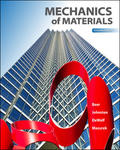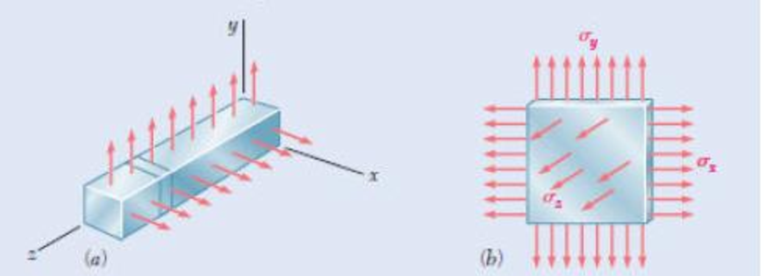
In many situations physical constraints prevent strain from occurring in a given direction. For example, ∈z = 0 in the case shown, where longitudinal movement of the long prism is prevented at every point. Plane sections perpendicular to the longitudinal axis remain plane and the same distance apart. Show that for this situation, which is known as plane strain, we can express ϭz, ∈x and ∈y. as follows:

Want to see the full answer?
Check out a sample textbook solution
Chapter 2 Solutions
EBK MECHANICS OF MATERIALS
- The state of plane strain on an element is represented by the following components: Ex =D340 x 10-6, ɛ, = , yxy Ey =D110 x 10-6, 3D180 x10-6 ху Draw Mohr's circle to represent this state of strain. Use Mohrs circle to obtain the principal strains and principal plane.arrow_forward4. The guy wire AB of a building frame is originally unstretched. Due to an earthquake, the two columns of the frame tilt 0=2°. Determine the approximate normal strain in the wire when the frame is in this position. Assume the columns are rigid and rotate about their lower supports. 0 = 2° 0=2° 3 m B 4 m 1 marrow_forwardDetermine the equivalent state of strain on an element at the same point oriented 30∘∘ clockwise with respect to the original element. ϵx′, ϵy′,γx′y′ =arrow_forward
- Determine the transverse strain in the x axis of the solid subjected to longitudinal tension. 4 cm 1 cm 6x10³ N 2 cm μ = 0,28 E=1,4x10" N/m² 6x10³ Narrow_forwardA thin wire, lying along the x axis, is strained such that each point on the wire is displaced Δx = kx2 along the x axis. If k is constant, what is the normal strain at any point P along the wire?arrow_forward(b) A differential element on the bracket as shown in Figure Q1 is subjected to plane strain that has the following components: ex = 150µ, ey = 200μ , γχν = -700μ. By using the strain transformation equations, determine:- The equivalent in-plane strains on an element oriented at an angle 0 = 60° counterclockwise from the original position. (ii) Sketch the deformed element within the x' – y' plane due to these strains. (iii) The stresses on the oriented planes in (i) where the value of elasticity, E = 200 GPa and Poisson's ratio, v = 0.32. (iv) Give your comments on those stresses in (iii) in terms of elastic limit/failure if the material's yield strength in tension/compression is 250 MPa and in shear is 90 MPa.arrow_forward
- Please answer only Handwritten.thank youarrow_forwardA rigid steel bar is supported by three rods, as shown. There is no strain in the rods before the load P is applied. After load P is applied, the normal strain in rod (2) is 1020 μin./in. Assume initial rod lengths of L1 = 148 in. and L2 = 78 in. Determine(a) the normal strain in rods (1).(b) the normal strain in rods (1) if there is a 0.043 in. gap in the connections between the rigid bar and rods (1) at joints A and C before the load is applied.(c) the normal strain in rods (1) if there is a 0.043 in. gap in the connection between the rigid bar and rod (2) at joint B before the load is applied.arrow_forwardA rigid steel bar is supported by three rods as shown. There is no strain in the rods before the load P is applied. After load P is applied, the normal strain in rods (1) is 4150 μm/m. Assume initial rod lengths of L₁ = 1,250 mm and L2 = 2,000 mm. Determine the normal strain in rod (2). (1) 4₁ Rigid bar (2) O 2849 μm/m O 3261 µm/m O 3071 µm/m O 3584 µm/m O 2594 μm/m B P L₂ C (1)arrow_forward
- The normal strain in a suspended bar of material of varying cross section due to its own weight is given by the expression γy/3E where γ = 2.9 lb/in.3 is the specific weight of the material, y = 3.4 in. is the distance from the free (i.e., bottom) end of the bar, L = 17 in. is the length of the bar, and E = 24000 ksi is a material constant. Determine, (a) the change in length of the bar due to its own weight. (b) the average normal strain over the length L of the bar. (c) the maximum normal strain in the bar.arrow_forward5 decimal places Determine the total strain (mm/mm) of a 2.64-m bar with a diameter of 21 mm subjected to a tensile force of 71 kN at a temperature increase of 49 C°. Consider the α=27.3 µm/mC° and E = 122 GPa.arrow_forwardA thin polymer plate PQR is deformed such that corner Q is displaced downward a distance L = 0.10 in. to new position Q' as shown. Determine the magnitude of the shear strain at Q' associated with the two edges (PQ and QR). P 25 in. 7982 μrad 6862 μrad 09533 μrad O6186 prad O8600 μrad 4 in. R 10 in. L Xarrow_forward
 Elements Of ElectromagneticsMechanical EngineeringISBN:9780190698614Author:Sadiku, Matthew N. O.Publisher:Oxford University Press
Elements Of ElectromagneticsMechanical EngineeringISBN:9780190698614Author:Sadiku, Matthew N. O.Publisher:Oxford University Press Mechanics of Materials (10th Edition)Mechanical EngineeringISBN:9780134319650Author:Russell C. HibbelerPublisher:PEARSON
Mechanics of Materials (10th Edition)Mechanical EngineeringISBN:9780134319650Author:Russell C. HibbelerPublisher:PEARSON Thermodynamics: An Engineering ApproachMechanical EngineeringISBN:9781259822674Author:Yunus A. Cengel Dr., Michael A. BolesPublisher:McGraw-Hill Education
Thermodynamics: An Engineering ApproachMechanical EngineeringISBN:9781259822674Author:Yunus A. Cengel Dr., Michael A. BolesPublisher:McGraw-Hill Education Control Systems EngineeringMechanical EngineeringISBN:9781118170519Author:Norman S. NisePublisher:WILEY
Control Systems EngineeringMechanical EngineeringISBN:9781118170519Author:Norman S. NisePublisher:WILEY Mechanics of Materials (MindTap Course List)Mechanical EngineeringISBN:9781337093347Author:Barry J. Goodno, James M. GerePublisher:Cengage Learning
Mechanics of Materials (MindTap Course List)Mechanical EngineeringISBN:9781337093347Author:Barry J. Goodno, James M. GerePublisher:Cengage Learning Engineering Mechanics: StaticsMechanical EngineeringISBN:9781118807330Author:James L. Meriam, L. G. Kraige, J. N. BoltonPublisher:WILEY
Engineering Mechanics: StaticsMechanical EngineeringISBN:9781118807330Author:James L. Meriam, L. G. Kraige, J. N. BoltonPublisher:WILEY





